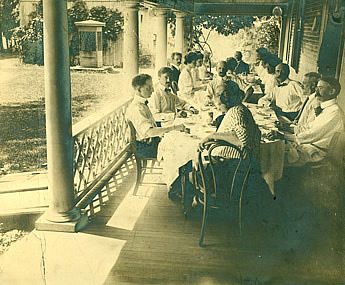Collections
In Situ: The Painted Panels
- The Museum will be closed Thursday & Friday, November 27 & 28.
Willard Metcalf (1858 – 1925)
Floral Still Life
A floral still life is not what one expects to see from the brush of Willard Metcalf. Indeed, this panel in the dining room is the only known example of a still-life painting by this noted landscape artist. It is one of three Metcalf panels installed as a group by 1908 in a prime spot in the dining room, set off from all others. A landscape is to the left of the bouquet, and a seascape is above them both. A fourth panel by Metcalf is installed diagonally across the dining room.
WILLARD LEROY METCALF (1858-1925)
FLORAL STILL LIFE, 1907-08
OIL ON WOOD PANEL
GIFT OF THE ARTIST
A "Floating" Bouquet in the Tradition of Hassam
Metcalf chose to present these cosmos casually, arranged without apparent care as to how each one might be shown to its best advantage. The off-center position of the vase and the asymmetry of the various white, pink, and gold blooms moves one’s eye about and keeps the bouquet from appearing static. (Perhaps the flowers were selected from Miss Florence’s gardens behind the house which have been recently replanted.) The white highlights on the glass bowl (a rather larger bowl than one might expect) as well as the sweeps of grays and tans tease that a reflection of the room might be discernable on its surface. An unusual artistic choice is that the bouquet rests on no table or ledge but appears to float against a background painted to look like wood. (Metcalf’s friend Childe Hassam also “floated” a floral still life in a similar manner on one of his dining room panels)
Metcalf is credited with proposing that the Griswold House dining room be studded with painted panels like those at the Hôtel Baudy in Giverny, France.
A Man with a Plan
For the Hôtel Baudy Metcalf had painted the crowded French café scene titled In the Café (Au café), currently in the collection of the Terra Foundation at Giverny. Artist Harry Hoffman wrote Florence Griswold in March 1908 that some of the artists, Metcalf among them, took blanks to New York to work on during the winter of 1907-08.
“We have,” he assured her, “started to complete the panels that we brought down with us…we’ll have them done soon and shall forward them to you.” The edges of the panel are left unpainted suggesting that Metcalf knew the intended placement of the panel in the room and how much of the surface would have been covered with the wood strapping.




